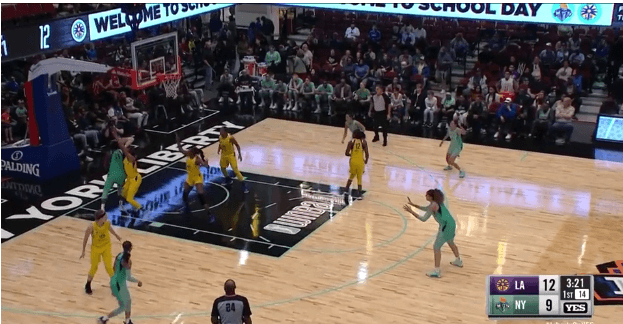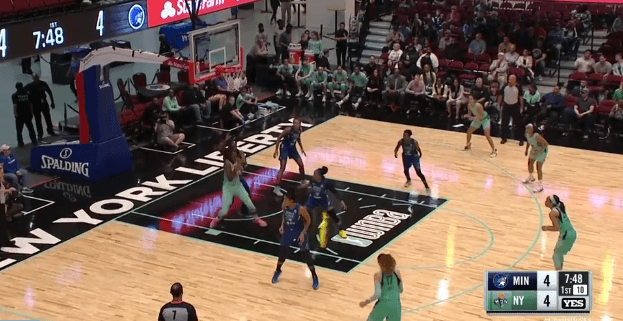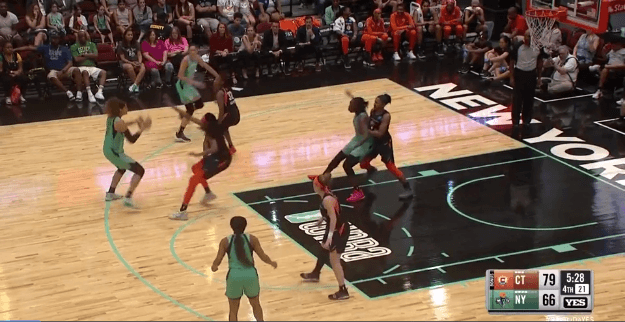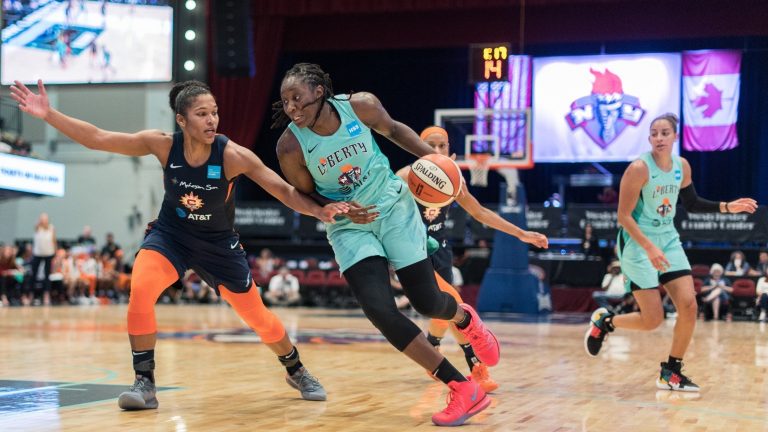The first half of the season wasn’t kind to New York Liberty star Tina Charles. Heading into the All-Star break, Charles had shot under 40% from the field in all but seven of New York’s games. But since the All-Star break, she’s shot under 40% just twice as the face of Liberty basketball has looked a lot more like the version that of herself that made her that star and not like the player who has spent most of this year near the bottom of analytics metrics like Player Impact Plus/Minus.
There’s obviously more to the discussion of how Charles has gotten back on track than just field goal percentage, but it’s a good starting point to look at how Charles has been playing on the past seven games. She’s passed the eye test as well over that time, playing more aggressively on the offensive end and taking — and making — higher percentage shots.
But, what’s changed? What was happening in New York before the All-Star Game that’s not happening now? Let’s dig into some data and see what we can come up with.
On/Off Lineup Data
While the WNBA’s official site has done a good job implementing more advanced data for us to consume, I still default to using Positive Residual‘s on/off data because it’s easier to zero in on certain time frames and see how certain lineup choices impacted a team. Let’s see if there’s any major changes to how Charles was being used earlier in the year versus now.
Before the All-Star break, the Liberty had a net rating of -9.2 in 595 minutes where Charles was playing.
That lowered to -15.3 when Charles and Amanda Zahui B shared the floor for 264.4 minutes, while the net rating with Charles on and Zahui B off was -4.2. The net rating when Zahui B was on the floor and Charles wasn’t was -2.4, though that was only in a 68-minute sample.
Conclusion #1: Before the All-Star break, lineups that featured Charles at the four and Zahui B at the five just weren’t working. A big part of this was that the team had a 19.3% offensive rebounding rate when the two shared the floor, which rose to 28.6% when they didn’t. This hurt the team’s ability to create second chances, which lowered the scoring upside.
But, these lineups should have worked fine. Zahui B has become more of a stretch five this year, so the paint shouldn’t have been super clogged, right?
Right, but were defenses treating Zahui B like a stretch five?
Well…not really!

Here’s a play where Charles is facing immense pressure down in the post. Zahui B is at the top of the arc, but no one is defending her. One of the points of using a stretch big is that it opens up the paint for your traditional, post big to work with less defenders, but that doesn’t work if defenses don’t go out and actually guard Zahui B.
It’s not even necessarily a Zahui B thing. Here’s a screenshot from a play against Minnesota back in June. Look at the defenders:

Brittany Boyd’s defender seems to have just forgotten that she was supposed to be guarding Brittany Boyd. Zahui B’s defender might as well have forgotten about her. Kia Nurse is wide open on the other side. This is probably a play where Charles should look to pass out, but earlier in the season Charles wasn’t looking to pass as much. She had a 9.8 assist percentage in June, for instance. In August, she’s got a 14.8 assist percentage. There’s a reason for her inefficiency early in the year: she wasn’t passing out of enough contested attempts.
But anyway, a concussion has kept Zahui B out for much of the recent games, but the small sample we have for the two playing together post-break looks like this: 51.4 minutes, a -6.0 net rating. That’s a big improvement, and I think a key part of that improvement is that defenses actually respect Zahui B on the perimeter now:

This play ends up as a Zahui B assist to Charles, in large part because Connecticut puts an on-ball defender on Zahui B. That gives Charles a one-on-one matchup in the paint and friends…yes, give me all the Tina Charles one-on-one matchups in the paint. If you can get Charles deep in the post with only one player on her, you take that every time.
Another thing we’re seeing more after the All-Star break is the Liberty getting Rebecca Allen involved at the four. I wrote specifically about the benefits of playing Allen there last week, and when I asked Katie Smith about this after the Wings game, she mentioned Allen at the four being something that helps create space for Charles.
And, well…yes. Since the All-Star break, lineups with Charles, Allen, and no other bigs have played 52.7 minutes. Those lineups have struggled defensively, posting 105.7 defensive rating, but the -5.7 net rating for those lineups is much better than the -17.4 net rating in 227 minutes since the break where the two either don’t share the floor or share it with Allen at the three.
One reason I’m excited about the return of Zahui B is that with defenses now actually fearing leaving Zahui B open and Allen shooting lights out from three, you can run a lineup with Charles at the four and Allen at the three and get the same benefits for Charles that you’ve been getting in the other lineups. This is a very small sample, but in the 10 minutes since the break that those three played together, the Liberty have a 14.5 net rating. Unsustainable? Sure. But it fits into this idea that surrounding Tina Charles with shooters will make Charles better and will make the team better.
Charles’ Shot Decisions
In addition to lineup-based reasons why Charles is playing better, I think she’s been making better decisions in terms of shot selection.
In June, Charles took 209 shots. 54% were in the paint, with 24% coming in the restricted area. 32.5% of her shots were midrange.
So far in August, Charles has taken 114 shots. 49% are in the paint, with 18% in the restricted area. 43% of her shots come in the midrange.
Now, this is going to sound weird coming from me, a noted fan of teams focusing on threes and shots at the rim. But Charles is very good when shooting from the non-restricted area parts of the paint and from midrange, and moving her away from the crowded basket has helped her score more efficiently.
Now, Charles is scoring efficiently at the rim this month, something that’s been helped by the improved spacing. Charles has always preferred the midrange. Last year, she took more midrange shots than shots in the restricted area. Same story in 2017. In 2016. Etc. Etc.
Tina Charles getting more spacing and using that spacing to move a little further from the basket suits her game well. More comfortable and open shots = more efficiency.
It’s also worth noting that Charles’ current surge is probably also indicative of the fact that she remains one of the top players in the league. Players go through shooting slumps, but it can become more magnified in a league like the WNBA where there are less games in the season. Charles had a rough month or two that wasn’t helped by defenses’ constantly doubling and tripling her, but as the offense around her gets more dangerous and the natural ebb and flow of shooting regresses in a positive direction for her, the numbers look better. I think that all of the talk of Charles declining earlier in the year was very premature, and that the early struggles of the Charles/Zahui B pairing this year had more to do with Charles not passing the ball out and defenses not respecting Zahui B’s range than it does with any kind of longterm issue of playing the two together. Yeah, they sacrifice some rebounding, but the offensive potential of a Zahui B/Charles/Allen front court with some combination of Nurse, Asia Durr, and Marine Johannès at the guard spots would be a lot of fun to see for stretches.
Anyway, Tina Charles. She’s still very good at basketball.

